Connecticut is a compact state, some 60 miles wide by 100 miles across. When I studied a map of this coastal New England state, I began to notice that practically every road around its borders is marked a scenic route. So I considered that a perimeter run was in order to taste the spice of the Nutmeg State.
I crossed the Appalachian Trail and entered the Litchfield Hills on my BMW near Salisbury in the northwest corner of the state and glided beneath the highest point. I scooted between idyllic Twin Lakes and found repast in Canaan at Collin’s Diner, a National Historic Landmark. Through the old mill town of Winsted there are no fewer than four impressive stone churches, and the brick facades of downtown look unchanged for generations.
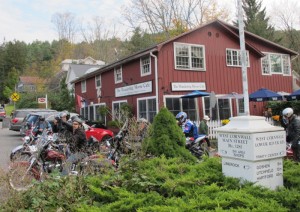
State Route 20 leads me to a glass blowing studio in Riverton and the landmark Hitchcock Chair Factory, founded in 1818. Hitchcock’s hand stenciled chairs are considered antique collectibles. North of Riverton, the road bores through a tree tunnel as it loops around the north end of Barkhamsted Reservoir. I pass through Colonial villages of West Granby, Granby and East Granby, where I take a side road to Old New-Gate Prison. The prison was originally a copper mine, opened in 1705. Political prisoners were confined here during the Revolutionary War. It later became a state prison, but closed in 1827 when it was considered costly to run and inhumane. Visitors today may enter the underground tunnels and decide for themselves.
I followed the airliners landing at Bradley International Airport, which serves Hartford, and located the New England Air Museum. In the lobby, I am startled by model airplanes almost invisibly suspended from the sky-blue ceiling in a mobile-like diorama. Two massive hangers display both military and civilian aircraft, helicopters and, interestingly enough, vintage motorcycles in Concourse condition. Down the road, I lingered in contemplative solemnity at the stirring Firefighters Memorial in front of the Connecticut Fire Academy.
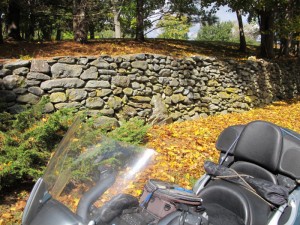
Crossing the Connecticut River at Windsor Locks leads to one of two trolley museums in Connecticut, the other in New Haven. My jog up U.S. Route 5 takes me to State Route 190 eastward. This rural road drives through woodlands for the most part. It begins to rain, and the descending autumn leaves have me worried about traction loss. I stop at Chelle’s 50’s Car Hop Diner in Stafford Springs for a hot chocolate and to don rain gear. Prudent decision, because now it rains harder, just as I encounter sweeping curves on State Route 197 to North Woodstock, where I turn south onto picturesque State Route 169.
Connecticut’s tranquil northeast corner, this area is called, and Route 169 is often listed as a top scenic drive. The length of this 37-mile route to Norwich started as a wagon trail traveled by Colonial settlers. Neatly-laid stone walls border the roadway alongside rolling hills with pastoral views. I pass village landscapes with town greens and Congregational church spires adding to the serene ride. The landscaped grounds and stone-bordered lawns of boarding schools appear in the town of Pomfret. An Audubon Sanctuary connects with the Quinebaug River Valley National Heritage Corridor, joining other nature preserves along this byway known as “The Last Green Valley”.
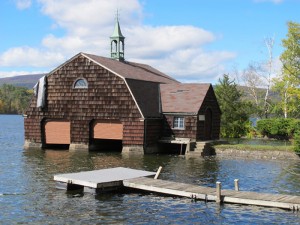
I diverted onto State Route 14A out of Canterbury, another Connecticut village with a National Historic District. I wanted to explore an adjacent green-dotted road nearer the border with Rhode Island, so I turned south onto State Route 49. Not a mile farther I came upon Ekonk Hill Turkey Farm and the Brown Cow Café. I sought sanctuary within, and the proprietor took pity as I dripped rivulets onto the wooden floor, presenting me with hot and spicy pumpkin soup on the house. The gobblers outside prompted me to order, what else, a turkey sandwich to accompany the owner’s largess.
Somewhat rejuvenated, I headed off down the road with a fresh perspective as the rain abated. I passed more examples of classic New England stone walls. Since the earliest days of the Republic, farmers have displaced glacially deposited rocks and formed walls to define property boundaries. I saw their decaying remains meandering off into the undergrowth. By the time I reached Stonington, Connecticut’s easternmost coastal community, the sky was clearing. I capped the day with genuine homemade New England clam chowder at Noah’s in downtown Stonington as the sun set over the harbor.
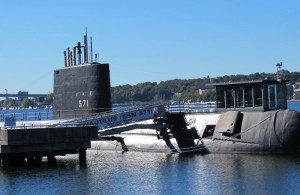
Morning found me on famed coastal U.S. Route l, extending from Maine to Florida. My little thread of it brought me over a Bascule bridge into Mystic Seaport, where I visited a recreated maritime village along a waterfront of restored whaling vessels. Just a few miles farther I stopped at Groton, where the world’s first nuclear powered submarine, the Nautilus, is now berthed as a museum outside the sub base. I was stationed here on a diesel submarine in the 1960s when the Nautilus and the Triton were the two only active nuclear subs in existence. I often viewed the U.S. Coast Guard Academy’s training vessel, the barque USCGC Eagle, sailing on the Thames River while I stood topside watch aboard my boat, USS Corporal SS-346. Those were the days!
Out of New London, State Route 156 hugged the coastline to Old Lyme, a 19th century arts colony worth exploring. A few Colonial inns beckon, including the Bee and Thistle dating from 1765. Crossing the Connecticut River and following State Route 154 slightly north brought me to Essex, where the town’s River Museum displays a working replica of the first submarine, Bushnell’s Turtle. Murals within depict the British burning the Colonial fleet of privateers in 1814. Also here you can board an historic schooner and experience the Connecticut River’s heritage, or explore the river valley aboard a steam train.
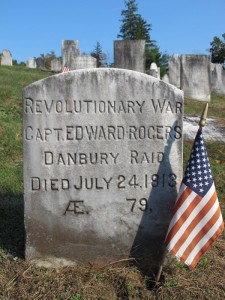
Back on slow-moving U.S. Route 1 past numerous beaches, I notice that it parallels fast-moving Interstate 95 to New Haven. Growing hungry, I hop into the frenetic mix that propels me toward the cityscape on a search for the landmark diner that is the reputed birthplace of the hamburger. I find Louis Lunch (Est. 1895) in a single-story cottage-like brick building on a busy street in downtown New Haven. I learn not to ask for ketchup or a bun. I innocently inquired what kind of cheese it had and was told “Delicious.” They don’t grill, but steam the meat. It may be an original, but I’ll stick with the traditional. I had expectations of visiting Yale University, alma mater of presidents, but New Haven’s intricate maze of one-way streets discouraged me, so I headed out of town.
I next desired to see the P.T. Barnum Museum in Bridgeport. It turned out to be an impressive stone and terra-cotta edifice with Byzantine and Romanesque architectural influences. Unfortunately, it is closed indefinitely because of tornado damage. The next two cities, Norwalk and Stamford, join Bridgeport as part of the greater New York City metropolitan area. In between is quaint little Westport, home of the late Paul Newman and his beloved Westport Country Playhouse, venerable home of New England summer stock.
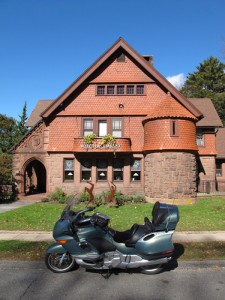
Past Stamford, in Connecticut’s appendix jutting into New York, I cut over to the Merritt Parkway, an architectural achievement highlighting its Art Deco bridges. One of the oldest parkways in the U.S., the Merritt is designated a National Scenic Byway and is listed in the National Register of Historic Places. It ends back in New Haven, but I leaped off onto U.S. Route 7 at Norwalk. Shortly thereafter, I veered left onto State Route 33.
More stone walls. Property boundary walls. Picket fences verboten here. This continues past Danbury, where I guide the BMW onto State Route 37 and encounter a continuation of the same. I imagine town planners decreeing no property complete without a congruent stone border. I recall Robert Frost’s poem, Mending Wall: Something there is that doesn’t love a wall; That sends the frozen ground-swell under it; And spills the upper boulders in the sun….
As I reenter the rolling hills of Litchfield County on U.S. Rote 7, I notice the motorcyclists proliferate. Drawing them into this region are 18th century hamlets with Colonial homes bounding classic village greens, in addition to covered bridges, waterfalls, and meandering byways through state forests. Riders congregate at Kent in front of the Coffee & Chocolate Company. South of town, they ride over Bulls Bridge spanning the whitewater gorge of the Housatonic River. North of town, past Kent Falls State Park, is another historic covered bridge leading to West Cornwall and the Wandering Moose Café. In between is the Sloane-Stanley Museum of Industrial History.
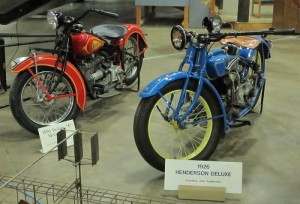
After making the circuit of said sights, I diverted at Cornwall Bridge to follow State Route 4 toward Sharon. Just outside of town, I stumbled upon an Audubon Wildlife Sanctuary. This facility cares for and releases injured and orphaned animals. Admission is free to view exhibits of reptiles, amphibians and birds. Surrounding the center is a nature preserve with a multitude of trails circling around and between two ponds. Time to get off the bike and stretch!
I learned that the numerous state parks in this region are a result of forest preservation. The landscape of western Connecticut was practically denuded of trees to feed iron furnaces, the remnants of which can be viewed in numerous places throughout the Litchfield hills. Early settlers also cut down large areas of forest to create pastures for grazing and fields for grain and hay. Reforestation efforts have restored the habitat of the Housatonic Valley, making it a haven for motorcycle travel.
My nutmeg sample is complete, but I must return to sprinkle more spice on morsels of Connecticut yet to be discovered.
(This is a web-exclusive article from May 2013 that did not appear in the print edition of Rider magazine.)
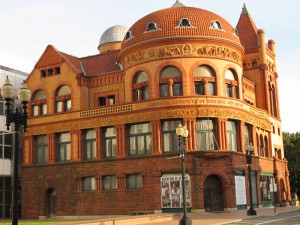 |
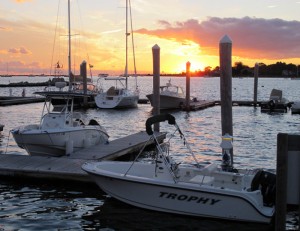 |









Wow that was an impressive ride. Did you do all of that in one day? How many miles and how long did it take you? I live in Stamford and the riding by me is not that good, up by Kent thought it get’s really nice and Litchfield area is very nice
Give it three days, although I started from Albany, NY.
I lived and rode in central CT for 15 years. Loved it. Next time try Rt 9A paralling the Conn River fro
Middletown to Saybrook, stopping at the Goodspeed Opera House and Gilette Castle. You’ll love it too.